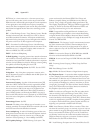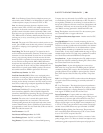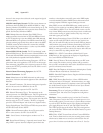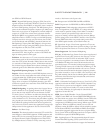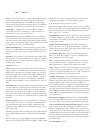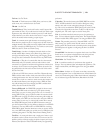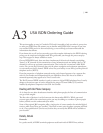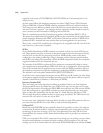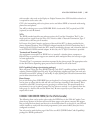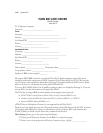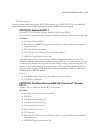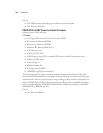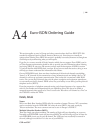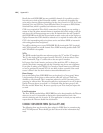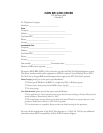116 | Appendix 3
regard for such arcana as 5ESS, DMS100, CSV/CSD, SPIDs, etc. Unfortunately, this is not
always the case.
At their central offices, the telephone companies use either AT&T/Lucent 5ESS, Northern
Telecom DMS100, or Siemens EWSD switching equipment. While each will work with the
Nx12, there are some differences which need to be taken into account when lines are ordered
and used. Each has a “protocol” – the language the user equipment and the telephone network
use to converse (on the D channel) for setting up calls and the like.
ere is a standard protocol that all switches may provide, called National ISDN-1 (NI-1).
is protocol was standardized and specified by Bellcore, the technical lab jointly owned by the
phone companies. However, both AT&T and Northern Telecom had versions of ISDN which
predated the NI-1 standard and some switches have not been upgraded to the new format.
ere is also a newer NI-2 standard, but it is designed to be compatible with NI-1 for all of the
basic functions, so this is also acceptable.
SPIDs
Service Profile Identification (SPID) numbers are required in all but one of the AT&T proto-
cols. ese numbers are given to the user by the phone company and must be entered correctly
into the Nx12 in order for the connection to function. SPIDs usually consist of the phone
number plus a few prefix or suffix digits. ere is frequent confusion between phone numbers
and SPIDs, even among Telco personnel. While the SPID frequently includes the correspond-
ing phone number, this is not necessarily the case.
e intention of the SPID is to allow the Telco equipment to automatically adapt to various
user requirements by sensing different SPIDs from each type or configuration of user terminal.
None of this matters with our application, but we must enter the SPIDs nevertheless. Most of
the telephone companies have agreed to implement a standardized SPID for new installations.
e standard is area code+phone number+0101 (XXXYYYZZZZ0101).
Your Telco service representative should give you one SPID for each B channel you order. Don’t
let the phone company installer leave without providing you with the phone numbers of your B
channels (called Directory Numbers, or DNs) and your SPIDs!
Directory Number (DN)
ese are simply your seven digit phone numbers as would be listed in your local telephone
directory and will need to be entered into your TWOx12 (in rare cases you may need to enter
the full 10-digit number). Normally each ISDN BRI circuit will have two DNs and two SPIDs.
Each DN corresponds to a given SPID and when you enter this information you must enter
them to reflect this relationship. You may also hear of a Listed Directory Number or LDN.
is is simply the primary number for lines in a hunt group (see below). e LDN need not be
entered in the unit, unless it is also one of your DNs.
In some cases, lines configured to hunt may deliver all calls to a single DN number. In this case
you must enter that DN for each of the DNs on each of the hunting channels
CSD and CSV
Recall that each ISDN BRI has two possible B channels. It is possible to order a line with one
or both of the B channels enabled – and each may be enabled for voice and/or data use. Phone
terminology for the class of service is CSV for Circuit Switched Voice and CSD for Circuit
Switched Data. (In contrast to PSD, Packet Switched Data, which is possible, but irrelevant to
our needs.)
CSD is not required for Telos Nx12 connections. Even though you are sending a stream of data,
the phone network knows to translate this back to analog at the far end due to the call setup
message sent on the D channel when the call is made. If this ISDN BRI circuit will also be used



